
German postcard by Krüger, no. 902/17.

American postcard by Universal-International Studios, Universal City, Calif. Photo: Universal. Sent by mail in 1960.
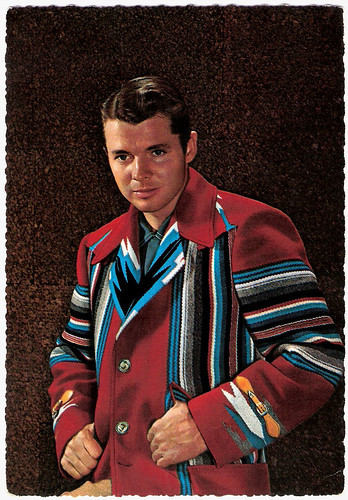
German postcard by Krüger, no. 902/18.
The most decorated American soldier of World War II
Audie Leon Murphy was born in Kingston, Texas in 1925. His parents were Josie Bell (Killian) and Emmett Berry Murphy, poor sharecroppers of Irish descent. There was great poverty in his family which counted eleven children, two of whom died. As soon as these children were old enough, they were employed to help earn a living.
His father disappeared one day and was never heard from again. Over the years, the mother became increasingly weak and died when Murphy was 16 years old. The three youngest children were sent to an orphanage and Murphy went to work, first at a petrol pump and then at a radio repair shop. When the Japanese attacked Pearl Harbor, he decided to enlist in the army.
On his seventeenth birthday, he applied to a Marine recruiting station but was rejected because he was not of sufficient weight. Finally, after another unsuccessful application to the paratroopers, he was accepted into the infantry. With the help of his sister, he had used a forged birth certificate, with 1924 as his date of birth, to make himself look old enough.
At Fort Meade, where his training was to be completed, he kept insisting on being sent overseas and in early 1943 Murphy landed with the rest of the troops in North Africa. He would become the most decorated American soldier of World War II and participated in combat operations for 27 months. Early in June 1945, a month after the German capitulation, Murphy returned to the United States, where he received a hero's welcome in his native Texas. He was honourably discharged from the army with the rank of a first lieutenant on 21 September 1945. Murphy became world famous when he appeared on the cover of Life (16 July 1945) as the "most decorated soldier".
After the outbreak of the Korean War in June 1950, he reenlisted in the 36th Infantry Division of the Texas National Guard. However, this division did not participate in combat. When Murphy left the Guard in 1966 it was with the rank of major. After Murphy returned from Europe, he bought a house in Farmersville for his eldest sister Corrine, her husband Poland Burns and their three children. His intention was that his youngest sister and two brothers, Nadine, Billie and Joe, who had been in an orphanage since their mother's death, would also move in with them but six children under one roof proved a bit much so Murphy took them in.

British postcard in the Picturegoer Series, London, no. W 818. Photo: Universal International.
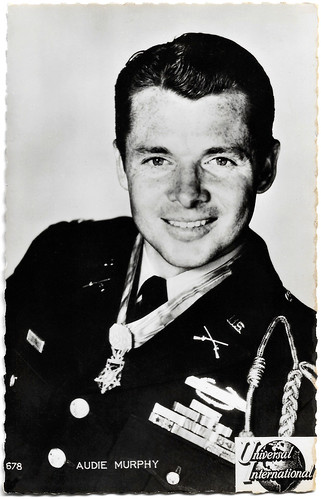
Photo: Universal International. Caption: Audie Murphy, the most decorated American soldier of the Second World War, stars in To Hell and Back.
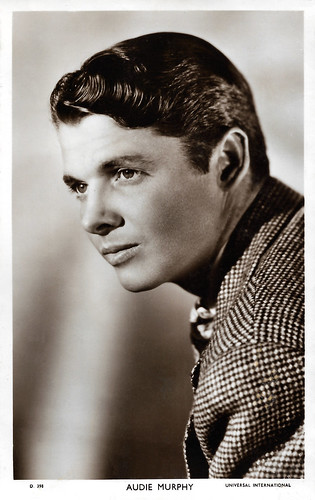
British postcard, in the Picturegoer Series, London, no. D 398. Photo: Universal International.
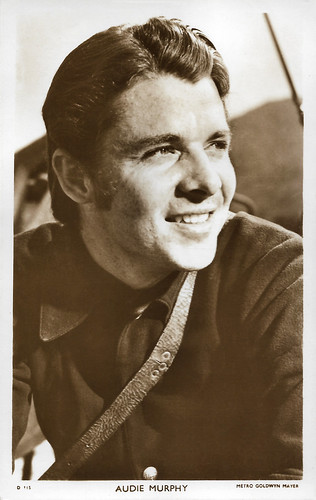
British postcard, in the Picturegoer Series, London, no. D 115. Photo: Metro Goldwyn Mayer. Audie Murphy in The Red Badge of Courage (John Huston, 1951).
To hell and back
After actor James Cagney had seen Audie Murphy's picture on the cover of Life magazine, he invited him to Hollywood in September 1945. The first years there were difficult for Murphy. Cagney Productions paid for acting and dancing lessons but was reluctantly forced to admit that Murphy - at least at that point in his career - didn't have what it took to become a movie star.
For the next several years he struggled to make it as an actor. Due to a lack of work, he became disillusioned, often ran out of money and slept on the floor of an old gym 'Terry Hunt's Athletic Club', owned by his friend Terry Hunt. He eventually got bit roles in the films Beyond Glory (John Farrow, 1948) starring Alan Ladd, and in Texas, Brooklyn and Heaven (William Castle, 1948) with Guy Madison and Diana Lynn.
In this third film, Bad Boy (Kurt Neumann, 1949), Murphy got a leading role. Murphy also appeared in the film adaptation of Stephen Crane's book The Red Badge of Courage (John Huston, 1951), for which he received rave reviews. Murphy wrote his autobiography 'To hell and back' in 1949 and it became a national bestseller. The book was written by his friend David "Spec" McClure, a professional writer.
He had great difficulty playing himself in the film version, To Hell and Back (Jesse Hibbs, 1955). He initially saw it as a kind of sell-out of his actions during the war and thought Tony Curtis should be given the lead role in the film. In the film, the reality was followed and Murphy's comrades died just as was mentioned in the book. At the end of the film, Murphy was the only member of his original regiment left.
During the ceremony in which Murphy was awarded the Medal of Honor, his friends were represented as ghosts. This was Murphy's idea to honour his friends. The film was a huge hit and brought in almost 10 million US dollars during its first years, setting a box-office record for Universal that wasn't broken for 20 years until it was finally surpassed by Jaws (Steven Spielberg, 1975).
One of his better pictures was Night Passage (James Neilson, 1957), a Western in which he played the kid brother of James Stewart. In 1959 he starred in the Western No Name on the Bullet (Jack Arnold, 1959), which was well received, despite Murphy playing a professional killer. He worked for Huston again on The Unforgiven (John Huston, 1960) opposite Burt Lancaster and Audrey Hepburn.
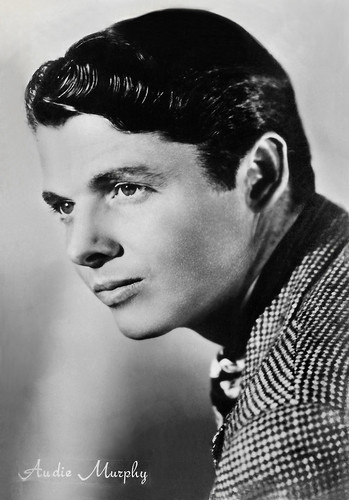
Italian postcard by Rotalfoto, Milano, no. 590.

West-German postcard by Filmbilder-Vertrieb Ernst Freihoff, Essen, no. 284. Photo: Columbia Film.
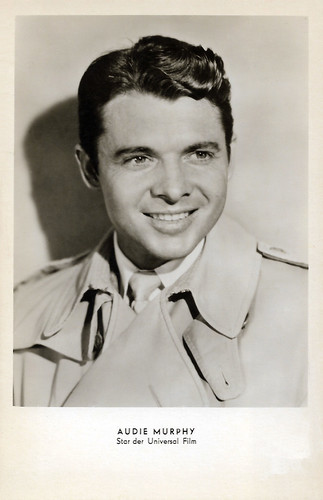
West-German postcard by Kunst und Bild, Berlin, no. A 1311. Photo: Universal.
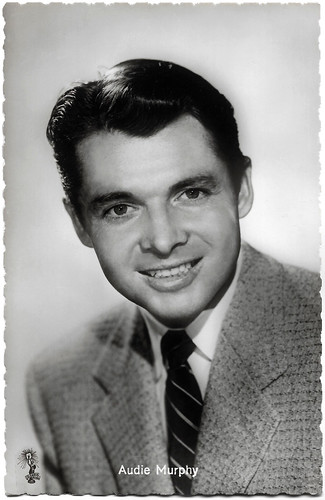
West-German postcard by Kolibri-Verlag G.m.b.H., Minden/Westf., no. 2487 Photo: Columbia. Publicity still for The Guns of Fort Petticoat (George Marshall, 1957).
Bouts of depression and nightmares
Audie Murphy was plagued by insomnia, bouts of depression and nightmares, probably a result of the many battles he had to fight during his life. His first wife, Wanda Hendrix, often spoke of Murphy's struggles. During the 1960s Murphy was addicted to the sleeping pill Placidyl for a time. When he realised he had become addicted he locked himself in a hotel room and taught himself not to use it.
He also broke the taboo of talking about war-related mental conditions. To draw attention to the problems of returning veterans from Korea and Vietnam, he spoke candidly about his own. He called on the US government to pay more attention to this issue and to study more closely the impact of war on mental health.
Meanwhile, the studio system that Murphy grew into as an actor crumbled. Universal's new owners, MCA, dumped its "International" tag in 1962 and turned the studio's focus toward the more lucrative television industry. For theatrical productions, it dropped its roster of contract players and hired actors on a per-picture basis only. That cheap Westerns on the big screen were becoming a thing of the past bode no good for Murphy, either.
The Texican (Lesley Selander, 1966) with Broderick Crawford, his lone attempt at a new, European form of inexpensive horse opera, to become known as "the Spaghetti Western", was unsuccessful. His star was falling fast. He made a total of 44 films, but Murphy was also a rancher and businessman. He bred and raised thoroughbred horses and owned several ranches in Texas, Arizona and California.
Murphy was also successful as a country singer and composer. He worked with Guy Mitchell, Jimmy Bryant, Scott Turner, Coy Ziegler and Ray and Terri Eddlemon, among others. Murphy's songs were recorded and sung by Dean Martin, Porter Waggoner, and Harry Nilsson, among others. His two biggest hits were 'Shutters and Boards' and 'When the Wind Blows in Chicago'.
In 1949, Murphy married film actress Wanda Hendrix and divorced her in 1952. He then married flight attendant Pamela Archer, with whom he had 2 children, Terrance Michael and James Shannon - named after two of his closest friends. Audie Murphy died in 1971 in a plane crash in the mountains of Virginia. Murphy was buried with military honours in Arlington National Cemetery. The official government representative was the decorated World War II veteran and future President G.H.W. Bush.
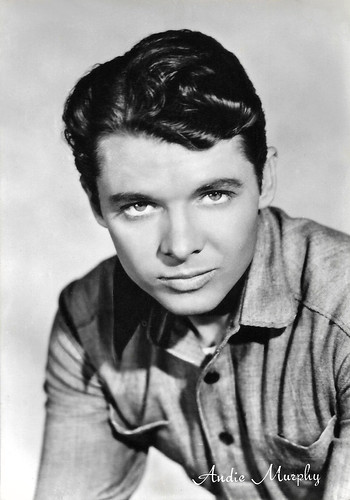
Italian postcard by Rotalphoto, Milano, no. 109.
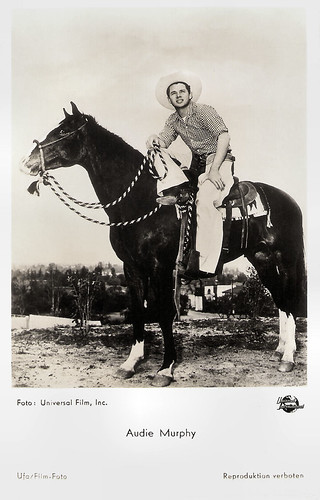
West-German postcard by Ufa/Film-Foto, Berlin-Tempelhof, no. FK 3386. Photo: Universal Film, Inc.
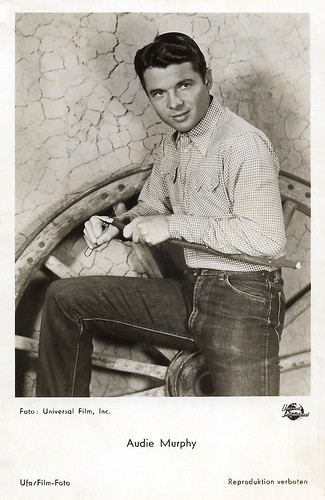
West-German postcard by Ufa/Film-Foto, Berlin-Tempelhof, no. FK 3387. Photo: Universal Film, Inc. Audie Murphy in Walk the Proud Land (Jesse Hibbs, 1956).
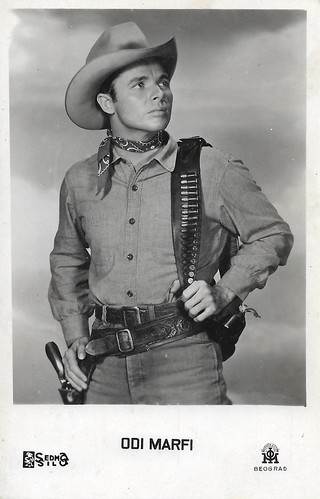
Yugoslavian postcard by Sedma Sila. Photo: Morava Film, Beograd (Belgrade).
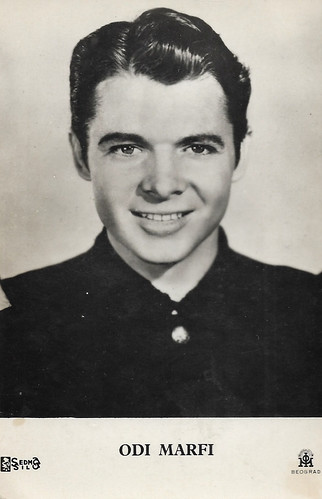
Yugoslavian postcard by Sedma Sila. Photo: Morava Film, Beograd (Belgrade).
Sources: Wikipedia (Dutch) and IMDb.
No comments:
Post a Comment